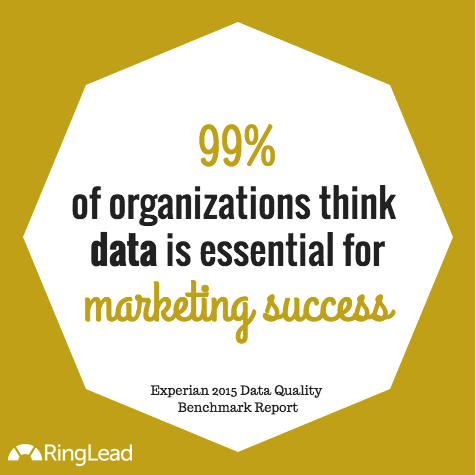
According to a recent Experian report, data quality is a growing space, and while 84% of companies are investing in a data quality solution, many are not sophisticated in their data strategy today. For instance, 32% of companies believe their data is inaccurate. Therefore, there’s still a long way to go in the world of ensuring quality data. In addition, there is a real need for data quality, because companies implementing data quality solutions see a significant increase in profits, among other benefits.
These stats and more come from the 2015 Experian Data Quality Benchmark Report. Here’s a recap of the report in the form of 48 insightful data quality stats.
Big Data Quality Takeaways
1. 95% of companies feel driven to turn their data into insight
2. 32% of U.S. companies believe their information is inaccurate
3. 26% of their total data might be inaccurate
4. 83% of commercial companies believe their revenue is affected by inaccurate and incomplete customer or prospect data
5. 63% of organizations lack a coherent, centralized approach to their data quality strategy
6. 94% of U.S. companies are leveraging data and data quality in an attempt to optimize their customer or prospect experience
7. 99% of organizations think data is essential for marketing success
8. 74% of companies feel they do not have a sophisticated data quality approach and could improve it
9. 27% are proactive about data quality
10. 14% are totally unaware of data quality
11. 91% of companies think revenue is wasted due to poor contact data
12. 92% of companies say managing their data is challenging
Drivers for Maintaining High Quality Data
13. 47% say cost savings
14. 46% say increased efficiency
15. 55% say protection of their reputation
16. 51% say capitalizing on market opportunities through profiling
17. 35% say enabling more informed decisions i
18. 34% say compliance
19. 42% say a single customer view
20. 22% say a reduction of risk
Drivers for Turning Data into Insight
21. 53% say an understanding of customer needs
22. 45% say wanting to determine past marketing campaign performance
23. 49% say securing future budgets
24. 37% say wanting to increase the value of each customer
25. 51% say customization of future campaigns
26. 28% say wanting to find new customers
27. 4% say driving more traffic from one channel to another
How Data is Managed
28. 35% manage their data in a centralized way with a single director
29. 51% have some centralization, but many departments adopt their own strategy
30. 42% have data managed by a Chief Data Officer, Chief Information Officer, or Chief Technology Officer
How Data Quality Tools are Utilized
31. 33% use data quality tools for data cleansing
32. 29% use it for data enrichment and suppression
33. 31% use it for matching and linkage
34. 33% use it for standardization
35. 43% use it for Data profiling
36. 42% use it for monitoring and audit
37. 30% use it for manual data cleansing
Data Quality Plans for the Future
38. 51% of companies plan to prioritize and improve data quality solutions they already have in place
39. 64% will focus on a new solution
Biggest Reason for Data Errors
40.The most common cause of contact data accuracy issues is human error
41. 51% say the biggest reason for data errors is incomplete or missing data
42. 48% say it’s outdated information
43. 44% say it’s inaccurate data
44. 32% say it’s duplicate data
How Data Quality Issues are Detected
45. 57% say data quality issues are detected when reported by employees, customer or prospects
46. 35% say it’s detected during an analysis of marketing campaign results
47. 44% take proactive data audits
48. 24% use specialist detection software
As Inga Romanoff shares, “Data quality is not an accident.” Which stats stand out to you?
Achieve total data quality with the free data quality guide below.
This article was syndicated from Business 2 Community: 91% of Companies Feel Poor Data Wastes Revenue (And 47 More Data Stats)
More Technology & Innovation articles from Business 2 Community:





